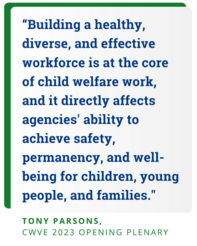
1. Use data to understand your workforce and their needs. Conducting agency surveys on climate and culture can help agencies understand the needs and demographics of their workforce. Collect and analyze workforce data to identify service gaps and disproportionality in the workforce or agency leadership and gain insights as to what interventions might work best.2
2. Inclusive hiring and recruitment practices. Having a role-balanced and diverse interview team, recruiting from communities that align with the population served, recruiting from historically Black colleges and universities, Hispanic Serving Institutions, and Native Tribal Universities or Colleges, and using an interview rubric can all help create a more inclusive hiring process. Implement strategies that minimize prejudice during recruitment, like using anonymized resumes to avoid favoritism based on a candidate’s name or educational institution. Beyond recruitment, ensure there are advancement opportunities for leaders of color. Offering coaching and mentorship programs and establishing career pathways or options for staff to make lateral moves based on evolving skills and interests can add to a culture of growth.3
3. Integrate lived experience. Authentically engaging individuals with lived experience ensures that they are included in the workforce and have access to specialized onboarding, individualized support, and peer support. Adequate compensation, role clarity, ongoing coaching and professional development, and opportunities to advance into leadership and grow within the agency are also crucial. This may include reexamining job descriptions. For example: can lived experience be considered in lieu of higher education for a particular role? Is a background check required for a particular position?
4. Create psychologically safe work environments. Creating a psychologically safe work environment means shifting from a compliance-driven culture to one centered on growth, continuous quality improvement, and learning, where acknowledging mistakes and taking risks are encouraged, not penalized. To achieve this, agencies need to foster a growth mindset and focus on enhancing cultural competency among their staff by providing ongoing training and resources that promote equity, inclusion, and belonging.4
5. Support child welfare staff in learning how to talk about race and using inclusive language. Developing shared language and guidance for staff will provide a foundation for open conversation.5 Strengths-based and inclusive language should also be reflected in agency forms, administrative paperwork, communication materials, staff onboarding materials, and trainings.
|